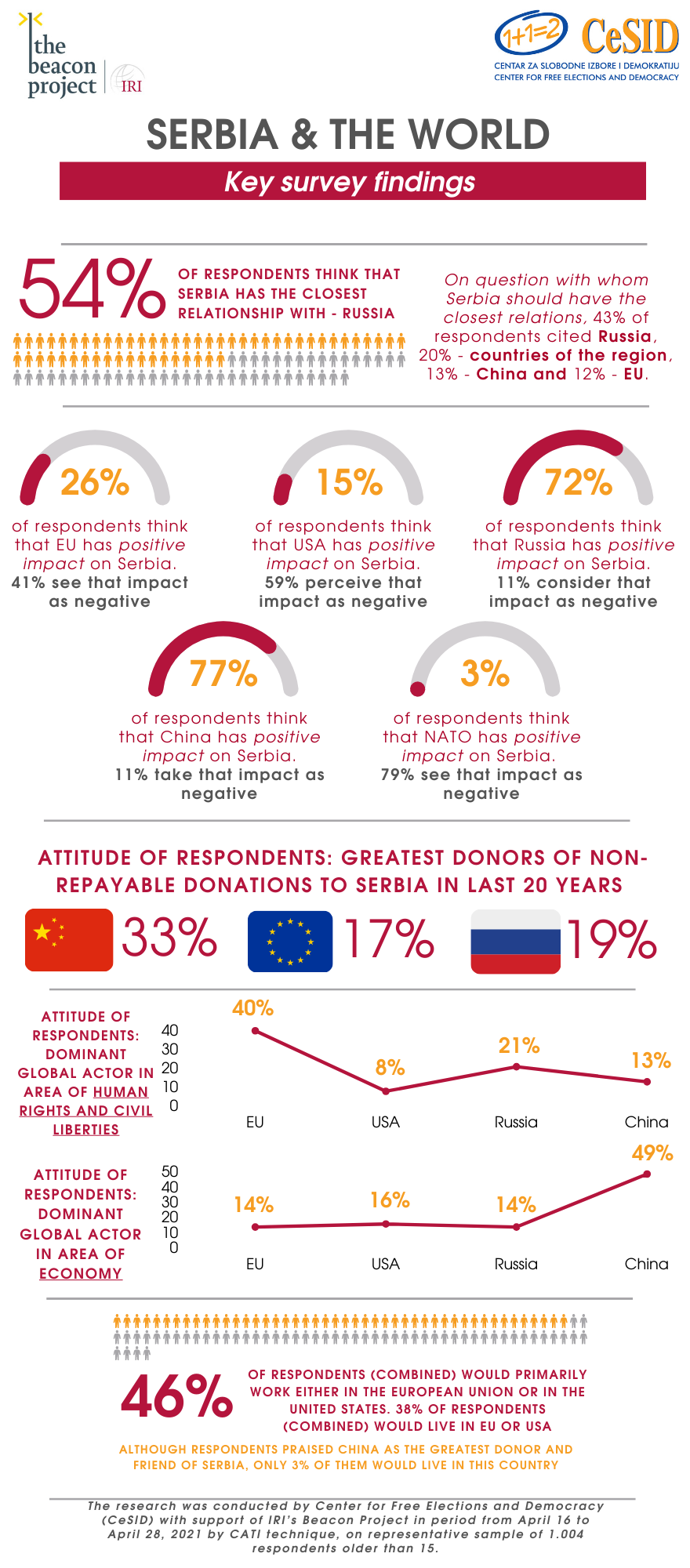Serbians are exceptionally interested in international relations and the country’s foreign relations. As many as 65 percent of those polled reported finding out about these issues from television; an additional one-third did so using online news sources, and a final 16 percent relied on social media. The choice of preferred media outlet for accessing foreign policy information depended on educational attainment, age, region, and place of residence. As such, the majority of the Serbian population – those with elementary or secondary education, half of whom are rural residents – is reliant primarily on television as the key source of news in all areas of day-to-day life.
Respondents’ attitudes towards potential global partners for Serbia are shaped by the impact of these actors on the country to date. The majority of those polled felt only China and Russia had had a positive influence on Serbia in recent years. A much larger proportion of those polled believed the United States (US), European Union (EU), and NATO had affected Serbia adversely than had a favourable view of their impact.
This is the reason why most Serbians perceived China and Russia as the countries that Serbia currently has the best relationship with. The EU came third. When the respondents were asked to cite countries that Serbia ought to have the closest ties with, Russia and China again topped the list, followed by neighbouring countries and the EU.
The respondents’ subjective feeling of greater closeness to China and Russia than the EU and the US was corroborated by their agreement, or lack thereof, with ten statements concerning donations and assistance to Serbia; economy and investment; and health and science. Even when it came to donations and assistance, where the EU and the US lead the field in Serbia, the respondents were convinced that Russia and China had provided more aid. Moreover, those polled expressed confidence in Chinese investment and infrastructural projects, preferred the Chinese and Russian Covid-19 vaccines to ‘Western’ ones, and felt the Russian economy was equal to that of the US. Lastly, the respondents also exhibited a large degree of Euroscepticism.
Apart from the obvious demographic characteristics that determine views of West and East, clusters of pro-Eastern sentiment were found amongst viewers of RTS and Pink, visitors to Telegraf.rs and visitors to Mondo.rs, and, in some cases, readers of Informer.
As many as one-third of all respondents believed that China had donated the most to Serbia in grants over the past 20 years. Russia came second, cited by 19 percent of those polled, followed by the EU, at 17 percent.
The answers clearly revealed that Serbians were pragmatic in terms of choosing countries where they would like to live, work, receive medical treatment, and study. Their economic opportunities make countries of the EU preferred places to live and work in. By contrast, Russia is seen as more attractive for studying and receiving medical treatment. The respondents believed China was the global economic leader, with close to one-half of those polled (49 percent) reporting this answer. China was more likely to be seen as the world’s most advanced economy by those with generally positive views of the East, residents of rural areas, and those living in Western Serbia and Šumadija. Conversely, respondents based in Belgrade and Vojvodina, as well as those with proWestern leanings, were more likely to cite the EU. Those polled primarily saw the EU as the key global actor in terms of human rights and liberties (as reported by 40 percent), whereas Russia was viewed as dominant in foreign affairs and the geo-political arena. The vast majority of respondents (71 percent) believed China had dealt with the Covid-19 pandemic the most effectively. Once again, the greatest proportion of those polled (41 percent) perceived the EU as the global stakeholder with the most advanced social, economic, and labour rights. Slightly under one-quarter (23 percent) believed Russia led the field in this regard, whilst 14 percent cited China.
Most respondents would like to see Serbia improve its economic relations with the EU and the US, as reported by 42 percent of those polled. Forging closer ties with these two actors in education and technology was ranked second (at 14 percent), as was greater co-operation to address the Kosovo issue (also at 14 percent). Economic interests were the key criterion that Serbia ought to apply when choosing which actors to work and build alliances with in the international arena, as reported by 57 percent of those surveyed.
Democracy was seen as the best form of government by fewer than one-half of all respondents (45 percent). By contrast, nearly one-quarter (24 percent) believed a non-democratic, strong-arm regime was the best option, with a final 27 percent seeing both choices as having their strengths and weaknesses. The proportion of respondents who chose non-democratic government increased with their age, whilst, by contrast, views of democracy as the best choice were more likely to be shared by the youngest cohort.
Two-fifths of those polled in this survey (39 percent) reported most commonly using the public broadcaster (RTS) toa access information. Pink was cited as the primary source of news by 15 percent. More than one-half of all respondents (53 percent) reported not using any of the news web sites or print media offered in the questionnaire. One exception, however, was Blic, which was read by 18 percent. Nearly three-quarters of all respondents reported never following online influencers; most of those who did claimed not doing so often (an aggregate of 24 percent, with 12 percent each claiming to do so ‘rarely’ and ‘occasionally’).
